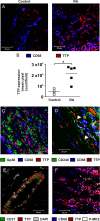Treatment of inflammatory arthritis via targeting of tristetraprolin, a master regulator of pro-inflammatory gene expression
- PMID: 27597652
- PMCID: PMC5446007
- DOI: 10.1136/annrheumdis-2016-209424
Treatment of inflammatory arthritis via targeting of tristetraprolin, a master regulator of pro-inflammatory gene expression
Abstract
Objectives: Tristetraprolin (TTP), a negative regulator of many pro-inflammatory genes, is strongly expressed in rheumatoid synovial cells. The mitogen-activated protein kinase (MAPK) p38 pathway mediates the inactivation of TTP via phosphorylation of two serine residues. We wished to test the hypothesis that these phosphorylations contribute to the development of inflammatory arthritis, and that, conversely, joint inflammation may be inhibited by promoting the dephosphorylation and activation of TTP.
Methods: The expression of TTP and its relationship with MAPK p38 activity were examined in non-inflamed and rheumatoid arthritis (RA) synovial tissue. Experimental arthritis was induced in a genetically modified mouse strain, in which endogenous TTP cannot be phosphorylated and inactivated. In vitro and in vivo experiments were performed to test anti-inflammatory effects of compounds that activate the protein phosphatase 2A (PP2A) and promote dephosphorylation of TTP.
Results: TTP expression was significantly higher in RA than non-inflamed synovium, detected in macrophages, vascular endothelial cells and some fibroblasts and co-localised with MAPK p38 activation. Substitution of TTP phosphorylation sites conferred dramatic protection against inflammatory arthritis in mice. Two distinct PP2A agonists also reduced inflammation and prevented bone erosion. In vitro anti-inflammatory effects of PP2A agonism were mediated by TTP activation.
Conclusions: The phosphorylation state of TTP is a critical determinant of inflammatory responses, and a tractable target for novel anti-inflammatory treatments.
Keywords: Cytokines; Fibroblasts; Inflammation; Rheumatoid Arthritis; TNF-alpha.
Published by the BMJ Publishing Group Limited. For permission to use (where not already granted under a licence) please go to http://www.bmj.com/company/products-services/rights-and-licensing/.
Conflict of interest statement
Figures






Comment in
-
Rheumatoid arthritis: Tipping the balance towards resolution.Nat Rev Rheumatol. 2016 Nov;12(11):622. doi: 10.1038/nrrheum.2016.159. Epub 2016 Sep 22. Nat Rev Rheumatol. 2016. PMID: 27652507 No abstract available.
-
PP2A plays a key role in inflammation and cancer through tristetraprolin activation.Ann Rheum Dis. 2017 May;76(5):e11. doi: 10.1136/annrheumdis-2016-210684. Epub 2016 Nov 3. Ann Rheum Dis. 2017. PMID: 27811146 No abstract available.
Similar articles
-
Targeting Tristetraprolin Expression or Functional Activity Regulates Inflammatory Response Induced by MSU Crystals.Front Immunol. 2021 Jul 16;12:675534. doi: 10.3389/fimmu.2021.675534. eCollection 2021. Front Immunol. 2021. PMID: 34335573 Free PMC article.
-
Calreticulin induced endothelial ICAM-1 up-regulation associated with tristetraprolin expression alteration through PI3K/Akt/eNOS/p38 MAPK signaling pathway in rheumatoid arthritis.Mol Immunol. 2019 Mar;107:10-20. doi: 10.1016/j.molimm.2019.01.005. Epub 2019 Jan 9. Mol Immunol. 2019. PMID: 30639474
-
Tristetraprolin (TTP)-14-3-3 complex formation protects TTP from dephosphorylation by protein phosphatase 2a and stabilizes tumor necrosis factor-alpha mRNA.J Biol Chem. 2007 Feb 9;282(6):3766-77. doi: 10.1074/jbc.M607347200. Epub 2006 Dec 14. J Biol Chem. 2007. PMID: 17170118
-
MAPK p38 regulates inflammatory gene expression via tristetraprolin: Doing good by stealth.Int J Biochem Cell Biol. 2018 Jan;94:6-9. doi: 10.1016/j.biocel.2017.11.003. Epub 2017 Nov 8. Int J Biochem Cell Biol. 2018. PMID: 29128684 Free PMC article. Review.
-
The control of inflammation via the phosphorylation and dephosphorylation of tristetraprolin: a tale of two phosphatases.Biochem Soc Trans. 2016 Oct 15;44(5):1321-1337. doi: 10.1042/BST20160166. Biochem Soc Trans. 2016. PMID: 27911715 Free PMC article. Review.
Cited by
-
Flemingia philippinensis Flavonoids Relieve Bone Erosion and Inflammatory Mediators in CIA Mice by Downregulating NF-κB and MAPK Pathways.Mediators Inflamm. 2019 Feb 17;2019:5790291. doi: 10.1155/2019/5790291. eCollection 2019. Mediators Inflamm. 2019. PMID: 30906224 Free PMC article.
-
Uncovering the Role of RNA-Binding Proteins in Gene Expression in the Immune System.Front Immunol. 2018 May 23;9:1094. doi: 10.3389/fimmu.2018.01094. eCollection 2018. Front Immunol. 2018. PMID: 29875770 Free PMC article. Review.
-
Bayesian Analysis of MicroScale Thermophoresis Data to Quantify Affinity of Protein:Protein Interactions with Human Survivin.Sci Rep. 2017 Dec 1;7(1):16816. doi: 10.1038/s41598-017-17071-0. Sci Rep. 2017. PMID: 29196723 Free PMC article.
-
The δ-Opioid Receptor Differentially Regulates MAPKs and Anti-inflammatory Cytokines in Rat Kidney Epithelial Cells Under Hypoxia.Front Physiol. 2020 Jan 21;10:1572. doi: 10.3389/fphys.2019.01572. eCollection 2019. Front Physiol. 2020. PMID: 32038276 Free PMC article.
-
Targeting Tristetraprolin Expression or Functional Activity Regulates Inflammatory Response Induced by MSU Crystals.Front Immunol. 2021 Jul 16;12:675534. doi: 10.3389/fimmu.2021.675534. eCollection 2021. Front Immunol. 2021. PMID: 34335573 Free PMC article.
References
MeSH terms
Substances
Grants and funding
LinkOut - more resources
Full Text Sources
Other Literature Sources
Medical

